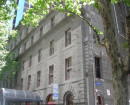WELCOME STRANGER TOURIST TRAIL
OLD BEALIBA-MOLIGAUL ROAD MOLIAGUL, CENTRAL GOLDFIELDS SHIRE
-
Add to tour
You must log in to do that.
-
Share
-
Shortlist place
You must log in to do that.
- Download report
Statement of Significance
This record has minimal details. Please look to the right-hand-side bar for any further details about this record.
-
-
WELCOME STRANGER TOURIST TRAIL - History
Contextual History:History of Place:
Heritage Inventory History of Site:
1850s Bulldog Reef: This reef has been worked both sides of the Bulldog or Black Lead. To the north, it was also called the Black Reef or Welcome Stranger Reef. On the south it was also Moliagul Reef ... The northern end was discovered in 1857 and by 1859 was returning 2 1/2 oz/ton ... a shaft was sunk to the west to work the reef at the 200 ft level.
1857: Bulldog Gully was opened in May 1856, and the Black Lead, of Welcome Stranger fame, in 1857.
May 1857: There was also a large rush on 25th May to Bulldog Gully ... but the gold was neither rich nor extensive, although there was a great number there.
1857: This reef was worked first at the time of the Bulldog Rush by all foreigners - Italians, Frenchmen and Jews - in August 1857, and the reef was yielding well at this time. It was also called Black Reef.
1859: Only one claim working on the Bulldog Reef, but it was averaging 2-1/2 ounces to the ton and was 40 yards long and 140 feet deep.
June 1859: Bulldog Reef [Moliagul] - 1 claims, 40yds aggregate length, yielding 2-1/2 oz/ton.
1860s Bulldog Lead, Black Lead: Nuggets - Welcome Stranger 2332 oz (1869), 113 oz (1869), 114 oz (1859), and 36 oz (1866). This was a well-established area by the time John Deason and Richard Oates found the Welcome Stranger. A piece of ground still occupied was a Chinese market garden cultivated by J. Youlk. Further down in Bulldog Gully were two dairies owned by Walter Brown and Mrs. Gutcher.
March 1861: [This reef] is being energetically and profitably worked.
1862: Number of claims working - a year of great reefing activity. About this time, Richard Meer’s ‘Reunion Co.’ had the reef - five acres on lease...
1867: ..1867 and later it was worked for a long time by McJuncken and party.
1869: Moliagul became famous when the ‘Welcome Stranger’ nugget was discovered by Cornish miners, John Deason and Richard Oates, at Bulldog Gully, Moliagul, on February 5th, 1869. The nugget was the largest found in Victoria, and the largest of the world’s nuggets. The gross weight was 2520 ounces. Some of the gold was kept by the finders, but the amount sold was valued at £9,553. Owing to the nuggets great size (about 2 feet long and 1 foot wide), it could not be weighed on the largest scales at the London Chartered Bank, Dunolly, so was taken to Walls’s blacksmith shop nearby, and reduced to a number of fragments on the anvil.
8th Feb 1869 - Welcome Stranger ... It weighed 210lbs gross and 2268 oz, 10 dwts, 14 grains of smelted gold have been obtained from it irrespective of a number of pieces of gold and specimens which have been given away by the finders. The finders are John Deason and Richard Oates, miners who have worked in this locality for about seven years and have a puddling machine there, and the nugget was found ... about an inch below the surface on the western side of the gully slope, going from Black Reef down to a gully which is known as the Bulldog Gully or Black Lead. They estimate the size as about 21inches in length and 10 inches in thickness, but unfortunately broke the nugget in three parts before they informed anyone of it. The spot where the nugget was found is about 50 yards west of the Bulldog Reef in which the quartz lode runs from one to four feet wide and has been worked to water at a depth of, say, 100 feet, and is about 200 yards east of the alluvial gully known as Black Lead, and where the depth of sinking is from there to 10 feet with a sandstone bottom. The nugget was found in some surfacing (of which from 10inches to a foot is generally puddled) of loose, gravelly loam, resting on thick red clay, with a bottom of sandstone about 10 inches from the surface. The actial amount paid for the gold sent to the bank was £9534.
Sept 1871: A lease has been taken up on the Black Reef and Stewart’s Reef, by a company to be styled the William the Conqueror Company, and mining operations are to be commenced forthwith. The reefs both yielded largely when originally worked, and the ground taken up includes that where the ‘Welcome Stranger’ nugget was got, which was found close to the cap of the Black Reef.
1896: In the 1896 activity in mining at Moliagul [this reef] was worked again by Lidge who got up to 2-1/2 ounces to the ton.
1897: The obselisk commemorating the finding was erected by the Mines Department in 1897 during a period of renewed reefing activity at Dunolly.
August 1898: Moliagul Consolidated Co ... timbered to surface from 82 feet.
Oct 1898: Moliagul Consolidated ... called for tenders to drive on course of leader from prospect shaft, close to Welcome Stranger obelisk.
Oct 1898: Erected whip frame. Monday, start Whip horse.
April 1899: Moliagul Consolidated - plant from Dunolly all delivered on mine. Boiler and plant to hand from Ballarat.
May 1899: One pair of poppet legs erected, next set raised today. Foundations cut, bed logs in position to carry horses for engines, pumping and winding gear.
August 1899: Boiler built in. Cutting down flue and excavating foundations for smoke stack. Overhead wheels in. Brace and railings will be finished next week. Costeening east and west to south of Welcome Stranger Monuement; 12 feet west of monument cut leader showing gold. This will trench along when further advanced with costeening.
Sept 1899: All brickwork finsihed; boiler and cistern finished. Steam pipes connected. Building house over boiler. Sinking winze on indicator near monuement.
August 1899: Shaft unwatered and timbered. Resumed sinking. Will open out at 200 feet to cut both reefs. Trenching new find west of main workings ... Accepted tender to dismantle, cart and erect battery.
Jan 1900: Moliagul Consol - Battery, ready to commence erection.
May 1900: Good progress connecting winding engine.
June 1900: Complete erection engines, expect coupled next week.
6 Dec 1900: Moliagul Consols - This lease (No. 3695) lies about 10 chains S-W from the Queen lease... Five hundred feet north of the main shaft, and within the area contained within the lease, is the ‘Welcome Stranger’ monument, an obelisk erected by the Mines Department to mark the spot where the ‘Welcome Stranger’ was found by John Deason and Richard Oats in 1869. A pumping and winding plant suitable for sinking to 300 feet is erected at the mine.
1901: The Moliagul Consols Mine which worked the Black Reef, south of the site of the Welcome Stranger discovery, closed, and its plant was auctioned in 1901.Heritage Inventory Description
WELCOME STRANGER TOURIST TRAIL - Heritage Inventory Description
Located in a Picnic Area is an information board directing visitors to a tourist trail, taking in a series of sites: the monument to the world's largest nugget; surface mining; John Deason's house; Deason's and Oates' puddler; Oates' house; Chinese grave; Chinese camp; puddler; cut forest; new growth forest (red and grey box trees); and Black Gully. The remains on the site reflect several of phases of working, covering aspects of both alluvial and quartz mining. The tourist trail identifies only the former, overlooking the remains of the Moliagul Consols mine that operated on the reef at the turn of the century. Apart from the monument the other prominent sites are: Moliagul Consols Mine/nLocated 120m S of the historic monument, just beyond the surfacing, within the forest, is the remains of the mine site. The remains consist of a mullock heap (partly quarried) measuring 25 x 15m and approx. 5m high, some shallow workings, and, on a level area, some almost-buried stone and mortar footings and depressions, associated with a spread of red bricks (hand-made, no frog). /nDeason's puddler/nA very worn-looking, ground-level puddler site. The central mound is barely distinguishable, and the central post is no longer present. The puddling trench has almost been buried by the erosion of the central mound. The puddling circle's diameter is approx 6.7m (22ft), and a small dam lies to the west./n2nd puddler/nThis puddler has a more fresh-looking appearance, and more distinguishable inner mound and raised outer mound. Despite its relatively recent appearance, the puddler is very eroded due to discharge from its associated dam. It appears to be a smaller puddler, probably only 6.10m (20ft) in diameter.
Heritage Inventory Signficance: National Estate EXISTING HERITAGE CLASSIFICATION: Moliagul Historic Reserve; LCC Study; McConville (1987) The siteÆs significance has already been well-documented. For example, McConville (1987): The site of the discovery and the reef (Bulldog Reef) are important as places central to Australian mining history. The Welcome Stranger discovery renewed local efforts at mining and at the same time attracted world-wide attention to the shire. The monument erected in 1897 testifies to this importance and at the same time is itself a part of the ShireÆs history. It is an early example of attempts to commemorate the endeavours of local miners. The surrounding gullies and mine workings still reveal some of the shape and character of a nineteenth-century mining field, even though they have been worked over several times. The monument and the discovery of the nugget are significant to the character of the Shire and are also central to Victorian mining history. Assessment of this study The site has: Historical significance because it is: a) associated with an important event; the discovery of the worldÆs largest nugget b) part of a group or network of sites, the totality of which is considered to be significant. Social significance because of its importance to the local or wider community. This is illustrated by the erection of the monument by the Mines Department and the recent creation of a tourist trial.
-
-
-
-
-
WATSON'S HILL
 Victorian Heritage Inventory
Victorian Heritage Inventory -
GOLDEN GATE CO AND THE CONTEST LEAD
 Victorian Heritage Inventory
Victorian Heritage Inventory -
NORTH BRITON LEAD
 Victorian Heritage Inventory
Victorian Heritage Inventory
-
-






